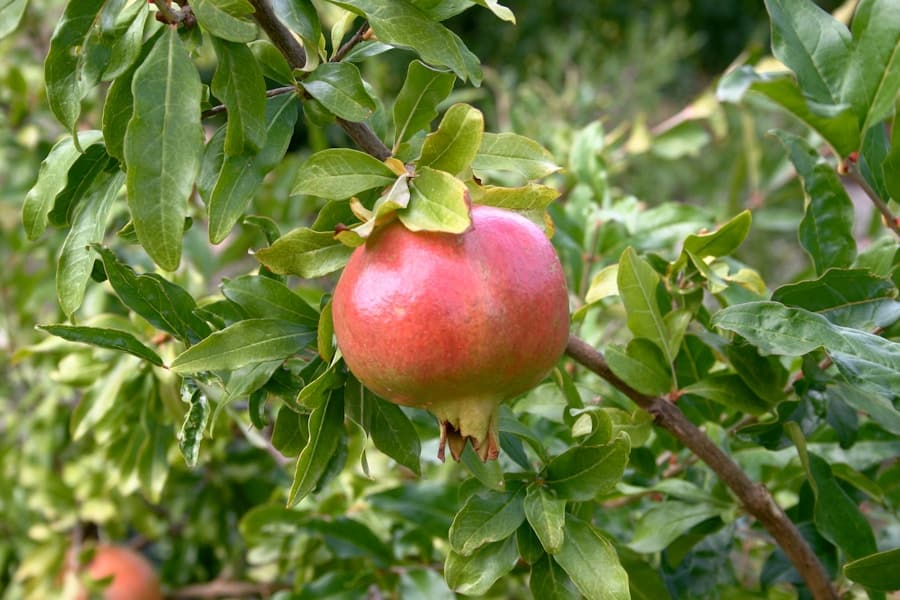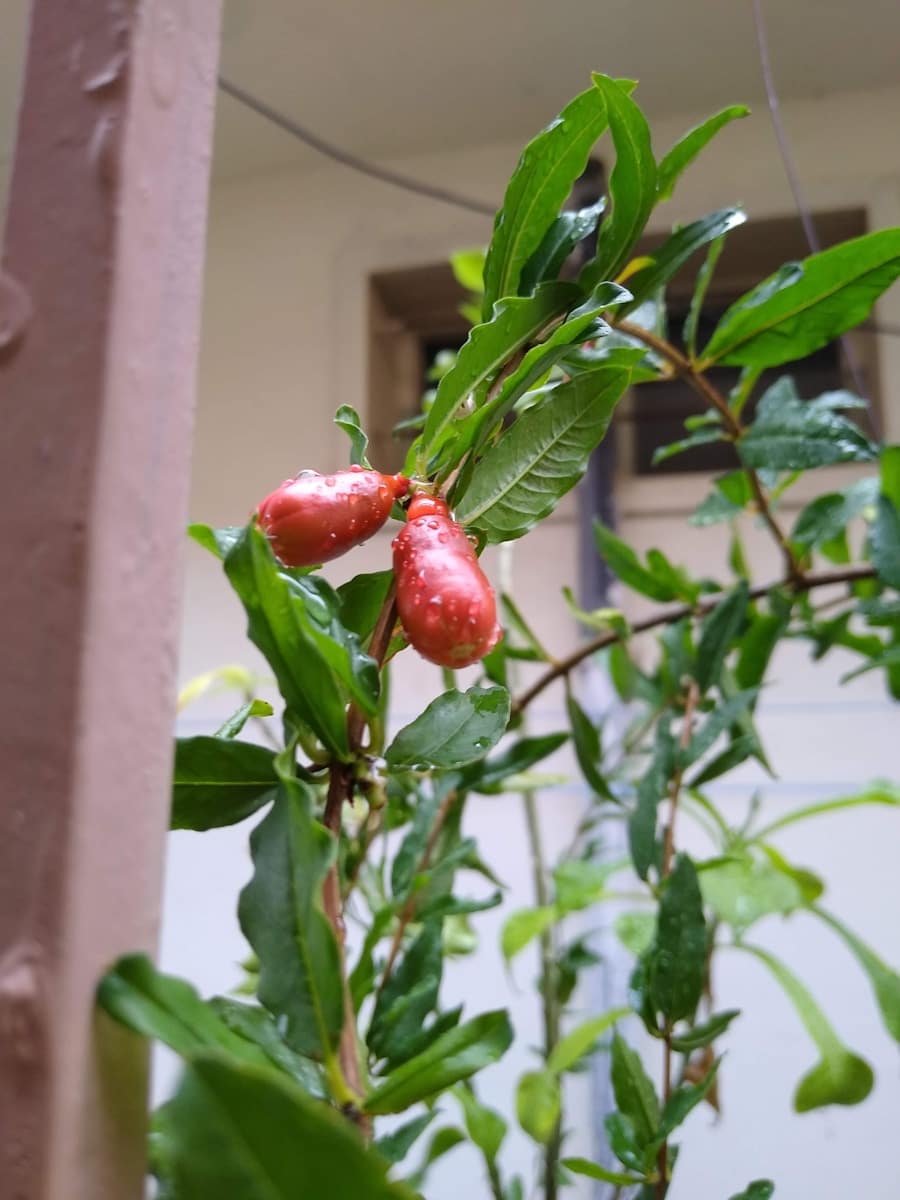Pomegranates (Punica granatum) are deciduous shrubs or small trees that thrive in warm, dry climates. They are native to the region extending from Iran to northern India and have been cultivated for thousands of years. The growth cycle of a pomegranate tree is fascinating, as it involves distinct phases that are influenced by environmental conditions, soil quality, and care practices.
Typically, pomegranate trees can reach heights of 5 to 10 meters and can live for over 100 years under optimal conditions. They produce vibrant, trumpet-shaped flowers that eventually develop into the fruit we recognize as pomegranates. The growth of pomegranate trees is heavily reliant on their root system, which is relatively shallow but extensive.
This characteristic allows them to absorb moisture and nutrients efficiently from the top layers of soil. Pomegranates prefer well-drained soils with a pH range of 5.5 to 7.0, which supports their growth and fruit production. The trees are also drought-tolerant once established, making them suitable for arid regions.
However, they do require adequate water during the flowering and fruit-setting stages to ensure a bountiful harvest. Understanding these growth requirements is crucial for anyone looking to cultivate pomegranates successfully. Check out the latest fertilizers for your garden at Soil Compost.
Key Takeaways
- Pomegranate trees thrive in well-drained soil and full sun, and can tolerate a wide range of soil types.
- Organic fertilizer promotes healthy growth and fruit production in pomegranate trees, while also improving soil structure and fertility.
- When choosing organic fertilizer for pomegranates, consider the tree’s specific nutrient needs and the soil’s current deficiencies.
- Apply organic fertilizer to pomegranate trees in early spring and late fall, and water thoroughly to ensure proper absorption.
- Maintaining healthy soil for pomegranate growth involves regular soil testing, mulching, and proper irrigation to support the tree’s nutrient uptake and overall health.
Benefits of Organic Fertilizer for Pomegranate Trees
Preventing Nutrient Leaching and Over-Fertilization
This slow-release mechanism helps prevent nutrient leaching and reduces the risk of over-fertilization, which can harm the trees. Moreover, organic fertilizers contribute to the overall health of the soil by increasing microbial activity. Beneficial microorganisms break down organic matter, releasing nutrients in forms that plants can readily absorb.
Enhancing Soil Fertility and Structure
This process not only nourishes the pomegranate trees but also enhances soil fertility in the long term. Additionally, organic fertilizers can improve water retention in sandy soils and drainage in clay soils, creating an optimal environment for root development.
Promoting Sustainable Agriculture and Reducing Chemical Inputs
The use of organic fertilizers aligns with sustainable agricultural practices, promoting biodiversity and reducing reliance on chemical inputs.
Choosing the Right Organic Fertilizer for Pomegranates

Selecting the appropriate organic fertilizer for pomegranate trees involves understanding their specific nutrient needs at various growth stages. For instance, during the early growth phase, a fertilizer high in nitrogen is beneficial to promote lush foliage and strong root development. Options such as composted manure or fish emulsion can provide the necessary nitrogen while also enriching the soil with other micronutrients.
As the trees transition into the flowering and fruiting stages, the focus should shift to fertilizers that contain higher levels of phosphorus and potassium. Bone meal is an excellent source of phosphorus, which supports flower and fruit development, while potassium-rich options like kelp meal can enhance fruit quality and resistance to diseases. It’s also essential to consider the nutrient content of any organic fertilizer being used; analyzing the N-P-K (nitrogen-phosphorus-potassium) ratio will help ensure that the chosen product meets the specific needs of pomegranate trees throughout their growth cycle.
How to Apply Organic Fertilizer to Pomegranate Trees
| Organic Fertilizer Type | Application Rate | Application Frequency |
|---|---|---|
| Compost | 20-30 lbs per tree | Once a year in spring |
| Manure | 10-15 lbs per tree | Once a year in early spring |
| Organic Granular Fertilizer | 1-2 lbs per tree | 3-4 times per year |
Applying organic fertilizer to pomegranate trees requires careful consideration of timing and method to maximize its effectiveness. The best time to fertilize is during the early spring when new growth begins, as this is when the trees are most receptive to nutrients. A second application can be made in late summer to support fruit development.
When applying organic fertilizers, it’s crucial to follow the recommended application rates provided by the manufacturer or based on soil tests. There are several methods for applying organic fertilizers, including broadcasting, side-dressing, and incorporating them into the soil. Broadcasting involves spreading the fertilizer evenly around the base of the tree, ensuring that it reaches the root zone without coming into direct contact with the trunk.
Side-dressing entails placing fertilizer in a band along the row of trees, which can be particularly effective for larger orchards. Incorporating fertilizers into the soil before planting or during soil preparation can also enhance nutrient availability.
Maintaining Healthy Soil for Pomegranate Growth
Healthy soil is fundamental to successful pomegranate cultivation, as it directly influences tree health and fruit yield. Maintaining soil health involves several practices aimed at enhancing its structure, fertility, and biological activity. One effective strategy is to incorporate organic matter into the soil regularly.
This can be achieved through composting kitchen scraps, yard waste, or using cover crops that are tilled back into the soil after they mature. These practices not only add nutrients but also improve soil aeration and water retention. Soil testing is another critical component of maintaining healthy soil for pomegranates.
Regular testing allows growers to monitor nutrient levels and pH balance, enabling them to make informed decisions about fertilization and amendments. If deficiencies are identified, targeted organic amendments can be applied to address specific nutrient needs. Additionally, practicing crop rotation and intercropping with legumes can enhance nitrogen levels in the soil naturally while reducing pest pressures.
By prioritizing soil health through these methods, growers can create an environment conducive to robust pomegranate growth.
Organic Pest and Disease Control for Pomegranate Trees

Pomegranate trees are susceptible to various pests and diseases that can significantly impact their health and productivity. However, organic pest control methods provide effective solutions without relying on harmful chemicals. Integrated Pest Management (IPM) strategies are particularly useful in managing pest populations while minimizing environmental impact.
This approach combines biological control methods, cultural practices, and mechanical controls to create a balanced ecosystem. For instance, beneficial insects such as ladybugs and lacewings can be introduced to control aphid populations naturally. Additionally, neem oil is an effective organic pesticide that can deter a range of pests while being safe for beneficial insects when applied correctly.
Regular monitoring of pest populations is essential; early detection allows for timely intervention before infestations escalate. Furthermore, maintaining tree health through proper fertilization and watering practices can enhance their resilience against diseases such as root rot or fungal infections.
Tips for Maximizing Pomegranate Yield with Organic Fertilizer
To maximize pomegranate yield using organic fertilizers, growers should adopt a holistic approach that encompasses proper nutrition, pest management, and cultural practices. One key tip is to ensure that trees receive adequate water during critical growth phases such as flowering and fruit set; this not only supports fruit development but also enhances nutrient uptake from organic fertilizers applied to the soil. Another important aspect is timing fertilizer applications strategically throughout the growing season.
For example, applying a balanced organic fertilizer in early spring can stimulate vigorous growth, while a phosphorus-rich fertilizer during flowering can promote better fruit set and quality. Additionally, mulching around the base of pomegranate trees can help retain moisture in the soil while suppressing weeds that compete for nutrients. Regular pruning is also essential for maximizing yield; it encourages better air circulation and sunlight penetration within the canopy, leading to healthier fruit development.
By combining these practices with organic fertilization techniques tailored to their specific needs, growers can significantly enhance their pomegranate yields while maintaining sustainable farming practices.
Sustainable Pomegranate Farming with Organic Fertilizer
Sustainable pomegranate farming hinges on understanding the unique growth requirements of these remarkable trees while leveraging organic fertilizers to promote health and productivity.
The integration of organic pest management strategies further supports sustainable practices by minimizing chemical inputs while maintaining healthy ecosystems around pomegranate orchards.
As awareness grows regarding the benefits of organic farming methods, more growers are likely to adopt these practices not only for economic gain but also for environmental stewardship. Ultimately, sustainable pomegranate farming with organic fertilizers represents a harmonious balance between agricultural productivity and ecological responsibility.
If you are looking for tips on how to choose the best fertilizer for your pomegranate plants, you may want to check out this article on how to save aloe vera plant. This article provides valuable insights on the importance of choosing the right type of fertilizer to ensure the health and growth of your plants. By following the advice in this article, you can help your pomegranate plants thrive and produce delicious fruits.
FAQs
What is the best fertilizer for pomegranate plants?
The best fertilizer for pomegranate plants is one that is high in nitrogen, phosphorus, and potassium, such as a balanced 10-10-10 fertilizer. Additionally, pomegranate plants benefit from fertilizers that also contain micronutrients such as iron, zinc, and magnesium.
When should I fertilize my pomegranate plants?
Pomegranate plants should be fertilized in the early spring before new growth begins, and again in late spring or early summer after the plant has finished flowering. Avoid fertilizing in the fall or winter, as this can stimulate new growth that may be damaged by cold temperatures.
How often should I fertilize my pomegranate plants?
Pomegranate plants should be fertilized once every 4-6 weeks during the growing season, from early spring to late summer. It is important to follow the instructions on the fertilizer package and not to over-fertilize, as this can lead to nutrient imbalances and potential damage to the plant.
Can I use organic fertilizer for my pomegranate plants?
Yes, organic fertilizers such as compost, manure, or organic plant-based fertilizers can be used for pomegranate plants. These types of fertilizers provide slow-release nutrients and improve soil structure, but it is important to ensure that they contain the necessary nutrients for pomegranate plants, such as nitrogen, phosphorus, and potassium.
Are there any specific nutrient requirements for pomegranate plants?
Pomegranate plants have specific nutrient requirements, including a need for nitrogen, phosphorus, and potassium, as well as micronutrients such as iron, zinc, and magnesium. It is important to choose a fertilizer that meets these requirements to ensure healthy growth and fruit production.

